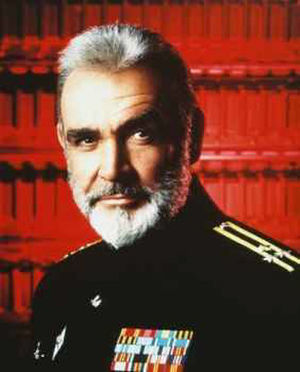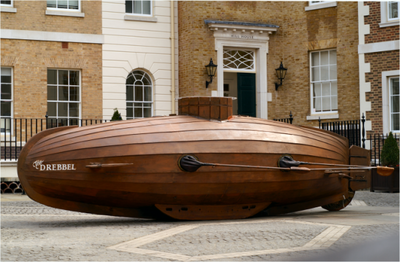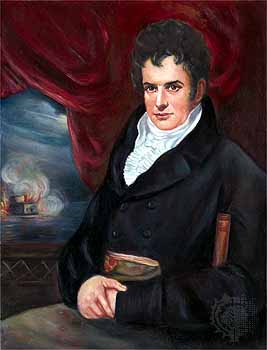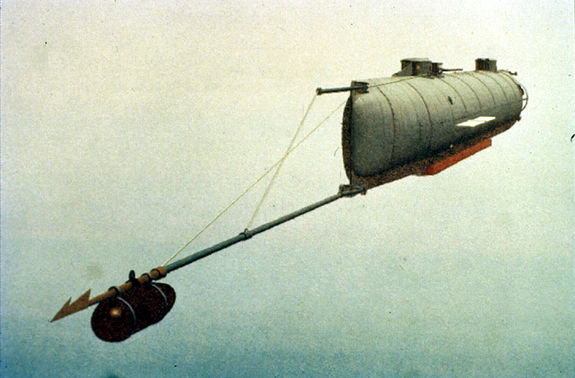Submarine
“ A submarine is a warship that travels under the water, while keeping the crew dry. If you place any of your limbs in its propeller they may get amputated. ”
Foreward from the Author[edit | edit source]
The following article is an amusing account of the submarine , I'm the author, and your host, Marko Ramius. You will no doubt be asking how a former 00 agent could be qualified to write this article, and that's a fair question.
After I retired from Her Majesty's secret service it was realized that no longer having to avoid bullets could be quite agreeable to my constitution. Unfortunately I failed to consider that retiring would result in somebody changing the lock on the door through which I gained access to young Hollywood starlets and sexy undercover agents of the enemy ...a situation decidedly disagreeable to agent 007.25, whom has been my willing co-conspirator since...well, since birth actually. When the Trojan company stopped sending me Christmas cards it became necessary to make drastic changes in my life. The fall of the Berlin wall gave me an idea. I stole the identity of a Lithuanian boy who died as an infant, I then learned to speak Russian and joined the Soviet Navy. The rest, as they say, is history. Now I am the captain of the world's largest submarine. She is the pride of Mother Russia and big brother to the Kursk. She is a Typhoon class Nuclear powered submarine named Red October. She's my baby.
Red Octobers' armament is quite substantial. Should a continent's worth of brown people start to get frisky, she can send 180 warheads to 20 separate locations and dry-roast 13 million turban wearing citizens in their own juices courtesy of her SS-N-20 ballistic missiles, next day shipment guaranteed.
In order to receive the greatest pleasure you will read this while imitating my Scottish/Russian accent. We begin with the wet dream of an English peasant.
A Wet Dream, the Origin[edit | edit source]
On May 4th, 1578, A man had a dream. He had a dream of travelling in a place no man had ever gone before. A place so isolated from humankind that today it could be likened to being on the surface of Mars. A place inhabited by creatures who breathed not with lungs, and walked not with feet.
The dreamer was a man named William Bourne. He was a British mathematician and a frequent writer on naval topics. His fantasy was to travel to a place more misunderstood than safe-sex practices in Somalia, and even more alien than a Wal-Mart in a Texas border town.
The place he dreamt of was the uncharted world below the surface of the ocean. Underwater, he wrote, "Is the only place on this wretched earth I could ever imagine which, if even only for 1 hour, would allow refuge from the constant abuse and harassment inflicted upon me daily by that product-of-incest-demon-whore of a woman I'm married to."
Within 5 minutes of awakening from the dream Mr.Bourne had completed blue prints in his hands as well as proof of concept for a vessel which would allow safe underwater passage, he then began to seek government funding for his business plan. All of these things were done before he even put his pants on that morning.
Unfortunately for William Bourne, the technology of the day would never allow the building of such a vessel in his lifetime.
He died soon after from a wooden spoon which impaled the base of his skull. The wound was self-inflicted.
History[edit | edit source]
The man who brought Bourne's dream from blueprint to reality was Cornelis Drebbel. Drebbel was a Dutch inventor who practiced alchemy. He constructed the first successful submarine in about 1620, likely while holding Mr. Bourne's blue prints in his hands. The sub Drebbel built consisted of a wooden frame covered in waterproof leather through which the oars protruded, just like in Bourne's design. Being an animal lover, Cornelis decided to deviate slightly from Bourne's specifications which called for the leather to be obtained from "small domesticated furry animals", and instead used skins from the backs of gypsies and pickpockets which were not only easier to procure, but also had a cleansing effect on the gene pool.
Drebbel constructed ever larger submarines which regularly navigated the Thames river (London) at depths of up to 15 feet. With help from a fellow alchemist, Drebbel solved the problem of a rapidly disappearing oxygen supply when submerged by taking aboard nitrate (saltpeter) which produced oxygen when burned. This lends credence to the story that the reason the vessel was able to stay underwater for hours on end was due to the "chemical liquor" that would replace "that quintessence of air" that was able to "cherish the vital flame residing in the heart" and was also found handy in "diffusing the stank which emanated from the asses of the oarsmen."
The first submarine to see military action was invented, accidentally, by David Bushnell of Connecticut. He and his fellow fraternity brothers from Yale were having a barrel party (precursor to the keg party) on the banks of the Niagara river when a party foul of epic proportions caused a barrel (with at least a pint of still-good beer remaining on the bottom) to go floating down river. Putting aside concerns of personal safety in the interest of rescuing God's golden nectar, ol' Dave dived into the icy waters head first while clutching the barrel lid to his chest to use as a flotation device. Swimming as if born with fins he reached the barrel in record time and climbed in. His joyfulness was quickly replaced by a feeling of regret however, regret at having decided to host a party 200 yards upstream of the tallest waterfall in the western hemisphere. Halfway into free fall he had 2 revelations in crash-course submarine engineering. They were:
- That all future submarine designs should incorporate water tight hatches secured by means more substantial than that of a death grip applied by 150 pounds of protoplasm.
And...
- That future designs should also incorporate means to eliminate wastes from the crew such as banana peels, egg shells...or freshly shit-stained trousers.
With fresh Dockers flappin' in the breeze, Dave decided for damn sure that his first foray into the water in a vessel of his own creation would be his last, and that his brother Ezra would henceforth assume all navigation duties.
With help from fellow classmate Phineas Pratt, David was able to build a working submarine. This sub, called Turtle, was assigned the task of attaching an underwater bomb to the British flagship HMS Eagle on the night of September 6/7 1776. The mission was almost cancelled due to the unfortunate sudden death of the only person ever to pilot the vessel, Ezra Bushnell (David's brother), just prior to the scheduled date of the mission.
The search was on for a new pilot, but who would replace Ezra? Who possibly could have the strength, the skill, the cojones? Who could possibly learn how to operate an experimental military vessel within an inconceivably short time frame and then single handedly carry out a successful mission against the largest battleship of the most powerful nation on earth? With the intent of promoting good karma between man and machine, David and Phineas put their heads together and in what could only be described as a stroke of genius, decided absolutely, positively, and without compunction, that the only person capable of pulling off this impossible mission was...well, any ol' jack-off named Ezra apparently. A quick look through the town log revealed 2 possibilities.
- Ezra Prophylactikmacher: German immigrant, patriarch of family with proud history of making delicate lamb-skin products of an intimate nature. Permanently unavailable due to his full time employment of pushing up daisies at the local cemetery.
- Ezra Lee: Army Sargent, alive and well. The mission was on!
Mr. Lee was not entirely successful however. Being unable to attach the explosive to the ship and with dawn soon to arrive, he was forced to abandon the mission and was subsequently pursued by a rowboat filled with thirsty British soldiers understandably perplexed at the sight of a gigantic self-propelled beer barrel. Lee managed to evade capture by jettisoning the heavy explosive which detonated shortly after, killing several fish.
Ezra Lee was credited posthumously as being the inventor of the sport of dynamite fishing, a sport for which the crimson necked homo-sapien is eternally grateful.
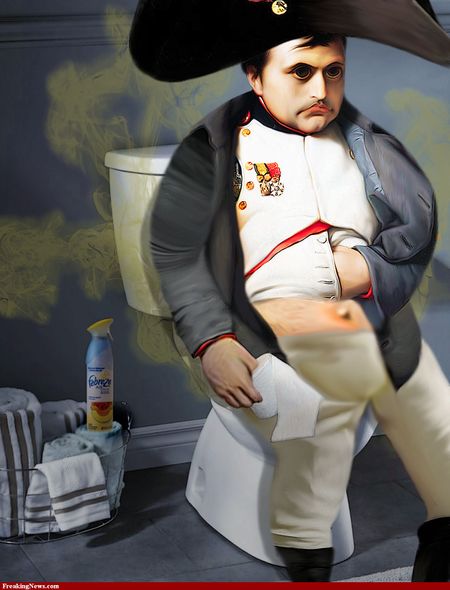
Fast forward a couple of decades. Benjamin Franklin had just returned from his triumphant 9 year mission in France of sweet-talkin' French chicks, using perfume in place of bathing, and secretly conspiring to bankrupt that entire country to pay for a little Revolutionary War he had going on back home. Upon his return he had his portrait painted by a talented inventor and artist named Robert Fulton.
Robert Fulton was an early pioneer in the development of underwater mines and torpedoes and was also the builder of the first practical submarine, the "French" Nautilus. During testing it dived to record depths, stayed submerged for hours thanks to an ingenious compressed air oxygen supply, and even used it's towed-from-behind mines to turn a 40 foot sailboat into splinters.
It was felt by a scholarly panel of 3 sent to evaluate the Nautilus that it could be used to sway the battle of sea supremacy against England in France's favor, Napoleon's response to this opinion was "Negre s'il vous plait!" (Nigga please!). The French ruling party felt that Monsieur Fulton's insistence on using explosives to destroy enemy shipping was lacking in refinement and was considered unsportsmanlike by those who practically wrote the book on battlefield decorum, i.e., those who considered that hurling at one's enemy that of craftily articulated obscenities laced with garlicky halitosis was the one true path to victory. Napoleon accused Fulton of being a swindler and a charlatan. Fulton was subsequently smuggled into England where his knowledge of explosives was put to use. Fortunately for France, Fulton accidentally left behind notes pertaining to the development of waterproof textiles, thus enabling future French subs to prominently display the white flag of surrender even while submerged, whether being attacked of not. Robert Fulton was born and raised in Lancaster County, Pennsylvania, neither of which are located in France.
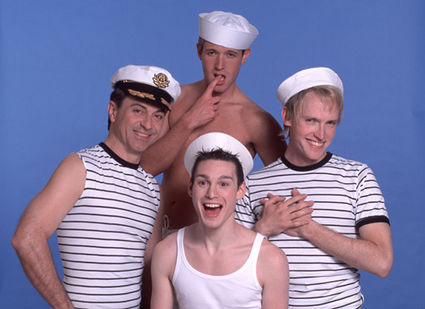
Now let's skip ahead about 60 years. The first successful underwater attack of a submarine against a surface vessel is about to be carried out by an American built vessel named after its builder, Horace L Hunley.
America at that time was far from the financial superpower that it is today, and was very much reliant on the attitude that one makes do with what one has. This attitude, symbolized by inventiveness, adaption, and improvisation when faced with a lack of building materials, is called Yankee ingenuity. The United States of America had this in abundance, as future crew(s) of the Hunley would soon discover to their dismay. Dismay? Yes. In order for the crew to benefit from this "Yankee ingenuity" the ship would have had to have been built in the United States, by Yankees. It wasn't. The C.S. Hunley was built in the Confederate States of America by a couple of good ole' boys down in Alabama, and in 1863 there weren't no damn Yankees in Al-uh-bam.
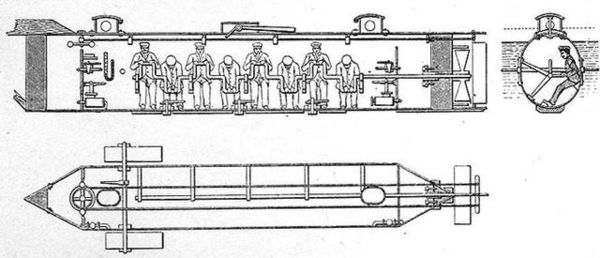
After semi-successful testing in Mobile bay, it was sent to help defend the Confederate stronghold of Charleston where it was promptly confiscated from Hunley and put into service by the Confederate Army. The Confederate Navy meanwhile was busy doing, um...something else I presume.
During its first trial in Charleston waters, the diving plane lever was stepped on causing the ship to suddenly dive. Unfortunately the hatch was left open during this exercise and the ship promptly sank, killing 7.
- USA 7, CSA 0
After the Hunley was raised it was brought dockside and moored to a steamship. This handy bit of information however was not relayed to the crew of said steamship who took off on their merry way (sub still attached), causing sub to turn over (hatch open), take on water and sink. This maneuver killed 6 of the sub's crew.
- USA 13, CSA 0.
The Confederates considered this a freak accident and raised the vessel again. On October 15 1863, Hunley was proudly back in service and went for a routine dive with a new captain aboard. The crew's brief for that morning's mission was short. It read as follows: "1. Dive ship. 2. Park vessel on ocean floor. 3. Remove all oxygen from vessel and replace with equal volume of water. 4.Conduct water breathing experiment. 5. Report back to base with results of experiment." The entire crew, including "captain" Horace L Hunley himself, performed these tasks admirably...except for the 5th part of the brief of course.
- USA 22, CSA 0.
A few days later the vessel was found by a diver and brought back to the surface, and this time it was dried extra thoroughly using only the finest towels. The commander of the Confederate forces defending Charleston, General Pierce Gustave Toutant Beauregard, rightly ordered that the vessel never be submerged again.
Being now extra dry, the vessel set out on it's first surface-only mission, during which it miraculously fouled a cable from a nearby ship, causing it to turn over (hatch open), take on water and sink, killing 7.
- USA 29, CSA 0.
Just for good luck the ship was raised yet again. And then on February 17 1864, history would be made and Confederate pride would be restored. Hunley went on a mission hellbent on revenge. It slipped quietly into the night headed towards the USS Housatonic with orders to send the Union ship to its watery grave. At about 8:45pm on that blustery cold evening, history becomes a little fuzzy. What's for certain is that either by attaching a torpedo to the hull of the ship or by simply ramming it in the side, the Hunley managed to sink the Housatonic. However, the ship was sunk in very shallow water allowing most of the crew to cling the the masts as they awaited rescue, thus only 5 were killed.
- USA 29, CSA 5. Yeeeee haw!
But before the Hunley's place in the annals of American history could be secured, it had some unfinished business to take care of. The engagement with the Housatonic also caused damage to the Hunley. Whether this damage was caused by the explosion or from ramming the enemy ship is not known. What is known is that soon afterwards the C.S. Hunley decided once again that it's crew needed to conduct water breathing experiments, only this time they needed to do them until the year 2000 which would be the next time the boat would see the light of day. The crew, ever faithful to the cause, were happy to oblige.
- Final Score: USA 38, CSA 5.
The C.S. Hunley was posthumously awarded the Congressional Medal of Honor by President Abraham Lincoln. This marked the first and only time in American history that this award was ever given to an enemy combatant, and also the first and only time that an inanimate object ever received it.
Whether or not the Hunley served as inspiration for Steven King's book/movie named Christine is unknown.
Suck, Squeeze, Bang, and Blow[edit | edit source]
Please redirect your thoughts from the gutter and turn them instead to the 4 strokes of the internal combustion engine. These are intake, compression, power, and exhaust. This is not to be confused with the external combustion engine which the French seem to have mastered, but we'll get to that later.
John Philip Holland was the first man to put an internal combustion engine in a submarine. He was born an Irishman and later moved to the United States.
In 1853 Mr. Holland attended Monastery school in Limerick and in 1858 was renamed Brother Philip after receiving the habit. He was unable to keep his thoughts pure indefinitely however, and began to stray from the flock. In 1868 Brother Phil was admonished for "occupying his mind with things quite foreign to his obligations, such as inventions and improvements in mechanical arts." This interfered with, and was in stark contrast to, the work he was ordered to perform in reconfiguring the monastic robe to allow it's wearer to maintain decorum whilst concealing a 7-year old boy.
A year later he developed his first sub design, and in in 1878 launched the Holland I, powered by a 4hp internal combustion engine.
Suck, Squeeze harder, Bang more slowly, then Blow[edit | edit source]
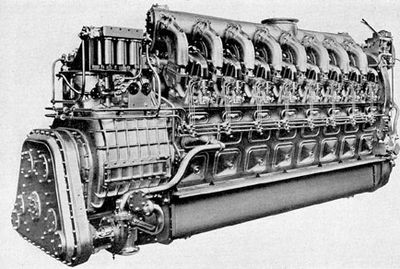
The first sub powered by a diesel engine was a French vessel named Aigrette.
An aigrette is made from the feathers of an egret, it is used to adorn a woman's (or a French man's) headdress. If the aigrette is to be worn by a lady of high society then it may be accompanied by a spray of gems and will be properly coordinated to the evening gown.
If I go any farther with that nonsense I'll spit-up my breakfast. Let us redirect our attention to the inventor of the diesel engine, shall we comrades?
Rudolph Diesel was born in Paris France....................
Dearest Lord... though I walk through the valley of the shadow of death, I will fear no evil, for thou art with me; Thy rod and thy staff, they comfort me. Amen.
Rudolph Diesel was born in Paris France, his parents were from the Kingdom of Bavaria, known today as Germany....thank you Jesus. With the outbreak of the Franco-Prussian War (France lost!) the Diesel clan was forced to immigrate to London where they had much difficulty adjusting to their new diet of Guinness and blood pudding.
Rudolph was an exemplary student, and would have many of his engineering ideas patented. The first engine he built was a steam engine which used ammonia vapor for fuel. This masterpiece of engineering was capable of extraordinary feats. With the engine happily chugging away on its first test run, this internal combustion engine decided that, without any warning, it would magically transform itself into an external combustion engine. This resulted in a hospital stay of several months for Mr. Diesel, as well as a newfound respect for window cleaner.
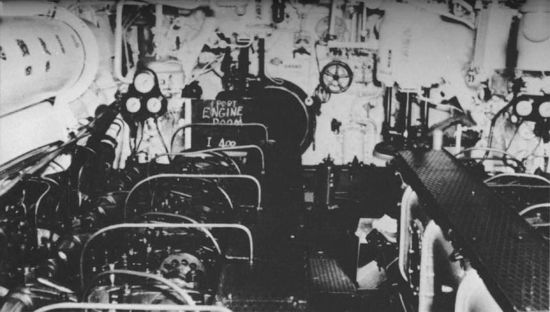
Diesel would later find employment with a blond-haired blue-eyed engineering company called MAN (Maschinenfabrik Augsburg Nurnberg). It was there that he would meet Gottlieb Daimler and Karl Benz, who before founding the "Lovers of David Hasselhoff Official Fan club" enjoyed moderate success producing engine designs that would one day utilize advanced exhaust-system technology to introduce certain [Jewish] users of German mass transit to the health benefits of carbon monoxide.
Rudolph would later need to make a return business trip to London, and would find himself aboard the steamer Dresden heading out from Antwerp on the night of September 29, 1913. Mr. Diesel went to bed at the usual hour but was awakened in the middle of the night by a horrific nightmare, he realized he would once again have to partake of English "cuisine." When questioned of the whereabouts of Mr. Diesel the following morning, witnesses reported that at about 3:15am they saw a man dart from his stateroom, mount the ships railing, and perform a flawless reverse one and a half somersault with three and a half twists into the icy north atlantic waters, never to be seen again.
Nations and their significant contributions[edit | edit source]
With Diesel/electric propulsion proving viable, all future innovations in submarine weapons, engineering, or wartime tactics would no longer be carried out by indivduals but by entire teams of morons for the country which they represented. The following dubious accomplishments of man and nation are presented for your entertainment, in no particular order.
U.S.S.R:[edit | edit source]
The former Soviet Union had the world's most amazing submarines that far surpassed those of the rest of the world in all key areas. So extraordinary were they that the only way to destroy them was with a Soviet built torpedo. However, Soviet subs were so maneuverable they could elude any torpedo, Soviet or not, that was fired at it. Of course the Soviets wouldn't have any reason to fire on their own vessel, nor did her enemies even have access to Soviet built torpedoes...so where would this "magic torpedo" come from? Ironically it was found that the only torpedos in ideal targeting position were the ones sitting comfortably inside the torpedo room of the destroyed-sub-to-be. Being so close to the target, nay inside the target, they couldn't possibly miss. To trigger the destruction it wasn't necessary for this torpedo to be armed, aimed properly, or even loaded into the tube. Indeed they were quite fond of detonating spontaneously without any outside encouragement, much to the delight of the crew.
Thankfully I wasn't the captain on any of those ships, and now that we can be proud to call ourselves Russians once again, those days are behind us for good...well there was that one time...oh never mind. Did somebody mention Poland!
Poland:[edit | edit source]
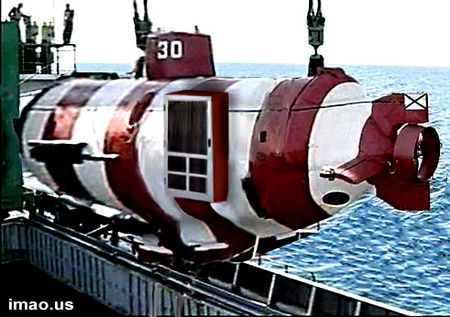
Hyman G Rickover was born in Poland, he possessed the IQ of a genius and would later immigrate to the U.S. where he would become the "Father of the Nuclear Navy". Had he stayed in Poland this chapter wouldn't have been necessary. Thankfully he left.
Polish expertise in metallurgy led to numerous advancements in hull design and manufacturing techniques. Most significant of these are the development and application of Screen Door (SD™) technology, used by both Polish and Iranian navies. Polish engineers discovered that replacing the really heavy steel hatch with one made of a lighter weight material reduced strain and wrist injuries when opening and also negated the air-conditioning system, what with all that cool breeze blowing in. The material they chose was a steel mesh much like that found on the screen door leading to the porch or to the backyard. Initial plans called for elimination of the hatch altogether making for near effortless entry and exit, but this idea was voted down over concerns of mosquito entry when patrolling lake Drawsko.
Unfortunately, all SD™ equipped submarines have inexplicably sunk. Though investigations are ongoing, Polish authorities have yet to publish their full report.
1960's U.K.[edit | edit source]
We all live in a yellow submarine, yellow submarine, yellow submarine...
Germany:[edit | edit source]
No proper discussion of submarines could take place without mention of Germany's vaunted U-boats. In German they are called unterseeboot (translation: undersea boat), a highly appropriate name derived from the fact that all but 4 of them are found under the sea, thanks largely to British and American depth charges and mines.
The term U-Boat entered the American lexicon during the dark early morning hours of May 7, 1915. Just off the coast of Ireland sat U-boat Kapitanleutenant Walther Schweiger aboard U-20. Walther was occupied looking through the periscope and sneaking passages from the newest addition to Oprah's book club as he repressed sweet memories of a sweaty,clandestine exchange with a single-testicled-Fuhrer-to-be. Just as the passenger liner Lusitania came into view he began quietly singing My Heart Will Go On to himself and he began to weep, for he faced a personal and professional dilemma. Should he leave the vessel be and face silent ridicule from the crew questioning his qualifications as Captain, the status of his masculinity as well as his heterosexuality, or should he sink it. To ensure the crew would go on thinking he was a big studly man, the gut wrenching decision was made to sink the vessel, and thus the closet door could remain closed for another day. He received strict punishment for this deed from the pink swastika Nazis, whose chosen torture method was the slap and tickle.
Japan:[edit | edit source]

The Japanese had a very interesting take on the submarine. Instead of the more traditional use of guns and torpedoes, Japanese designers thought that the sub Itself could be used as a weapon. This may be a slight hazard to the crewmembers inside, some of whom are not even given triplicated consent forms. Fortunately, we submariners have grown much more civilised since then.

